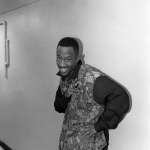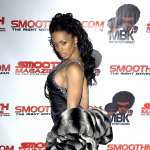In the second installment of our “Smirnoff Inspire series”, producer/DJ Easy Mo Bee talks about his early influences, his first pair of turntables and why he still does so much production by hand in the digital age.
“There was a company that was out called BSR. We’d make jokes that it stood for Bull S**t Record player.” – Easy Mo Bee
His early influences
The real Easy Mo Bee is my father, Osten Harvey, Sr. He would play stuff in the house like Kenny Burrell, Sam & Dave, Al Green, Sam Cooke. The stuff he played was an education. He’d play the US Bonds, Credence Clearwater Revival. He opened me up to all kinds of music. By the time I was 12 I knew I wanted to be a DJ, that’s where I started. I always loved the music. It’s a natural transition, just like Pete Rock, DJ Scratch. It’s a natural transition for a DJ to play records long enough until soon or later he wants to make ‘em.
Let me make this clear right now. There is a God but after Him, if it wasn’t for Marley Marl I wouldn’t be making beats right now. Before I even met him I considered him my mentor. I played such close attention to his production. Long before they made the Sp-1200 I dreamed that they would make a machine that sampled. Early drum machines came with factory pre-set sounds and back in ’84 I dreamed of a machine where you could take a kick from this record and a snare from this record and make my own drum kit. So when they made the Emu SP-1200…Ced Gee…man these are my heroes. Ced Gee from Ultramagnetic, who we believe did some of those early BDP records and the Ultramag stuff, Ced Gee and Marley were two of the most famed to get hold of the machine. So when I heard that stuff they made using the machine I dreamed off, I said that’s it, I’m producing. So I was like my brain and mind were not too small for thinking that. They created a machine to do that.
His first turntables…
There was a company that was out called BSR. We’d make jokes that it stood for Bull Sh*t Record player. It was one of those where the 45s would drop down in a jukebox kind of way. There was a sensor for the tone arm and if you put it near the end of the record, it would jump up. I hated that! So I couldn’t cut no breaks if they were near the end of the record because the needle would jump up. I put up with all kinds of stuff early on.
When I got my first real pair of turntables they were Techniques but they were the B-101s. Back at that time the B-1 and the direct drive D-1 was real popular. We had just passed through the 1600s and 1800s with the knob pitches on them. When I got the B-101s you couldn’t tell me nothing. I had a Numark mixer and I was DJing break beats, electronic, funk. My father’s old records. Then I watched Red Alert play “Rock Box” new on the radio. For a period hip-hop was all just about keyboards and drum machines. But when the sampling drum machines came along, hip-hop came alive.
Advice…
I still prefer to do things by hand. Sometimes I chop my stuff tight if I want that effect. But if you chop too tight or too close you’re chopping a snare or kick that already contained a reverb and EQ, so if you cut too tight, even it if it’s just .08 seconds worth, you’re not giving people a chance to experience that sound from the record.
I gave my MPC 3000 to my brother LG. He did the whole Ill & Al Scratch album, stuff like Nas’ “One Love” remix, stuff with Shaq, The Boogie Monsters. We both always had that bass heavy sound. That comes from growing up in the house and our father playing those 45s. I don’t care how digitally refined we become, ain’t nothing like dropping a needle on a 45. It’s such a full, warm sound and I always wanted my beats to sound like that.
Today I sit back and listen to stuff I did and say Easy you was either real high or a genius. People ask me “what were you thinking” and I wanted people to go back and listen to Busta’s “Everything Remains Raw.” It was not just a beat, but then it had decorations. There is a lot better equipment now but in the Sp-1200 when you slowed things down you’d get this real gritty, scratchy sound. The actual technical term for it is Ring Modulation. For the bit rate of the machine it can’t handle the frequency you’re taking it to. But today you could slow something down way slow and it’ll be crystal clear. That’s how they do those house mixes of R. Kelly and them. They take a slow record and time stretch it. Time stretching is effecting speed without affecting pitch and they even have turntables that did it. You can ask D-Nice or Kid Capri, Q-Tip, Funk Flex…DJ Scratch and Lord Finesse gave me time stretching lessons over the phone but I never mastered it. I do that stuff by hand. If a loop is 4 bars long, instead of using the 4 bar loop as a whole you go through the sample and chop down every step. Every step would be “boom, boom, boom” When you put things in a sampler you’re putting it against a metronome. Every step of the way you have to make sure the sample is real tight. So I give ode to all the digital equipment but I’ll still do it by hand. It makes me feel I did that. Some things just have to be done by hand anyway.
RELATED POSTS:
Ski Beatz Gives Props To His Mentor, DJ Clark Kent
“Master Of The Mix” DJs Explain Why They Risked Reputations For Reality Show [VIDEO]
DJ Premier On Battling Dr. Dre, BET’s Cipher And New Label [VIDEO]
Nicki Minaj Interview With DJ Drama [VIDEO] [fromHotSpotATL.com ]
Fantasia Tries to Settle Case from Alleged Affair [from Blackvoices.com]
It’s The Real’s ‘Jay ElecLeBronica’
[from TheBVX.com]
DMX Disses Jay-Z, Nice Cars and Pool Parties [from TheBoombox.com ]
Kanye West’s 50 Greatest Beats [from Vibe.com ]
Vanessa Williams: 47 & Nude On Cover Of Ebony [PHOTO] [from TheBoxHouston.com]
<p>Facebook Live Is Loading....</p>




